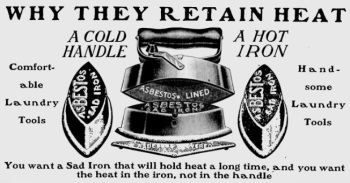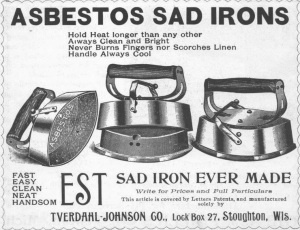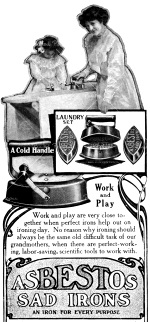
The Asbestos Sad Iron design really did use asbestos. It was under the handle, inside a “hood” or cover that fitted over a heated “core”. It “bottled up” the heat, said an ad, so it was all channeled through the hot solid steel surface that pressed the clothes smooth. No heat rose upward to bother the woman ironing. The handle stayed 15 degrees cooler than blood temperature, claimed the Dover Manufacturing Company in early 1900s USA, and the cores needed reheating less often than other flat irons. This brand flourished just before electric irons helped bring cooler, less fatiguing ironing days.
Hot iron, cold handle
The main selling point was the cool handle on a hot iron. A 1906 ad explains this, and more:
The Asbestos Sad Iron handle…is attached to a steel shield, separated by an air space from the hood, thus preventing any conduction of heat to the hand. The asbestos lined cover, when placed over the throroughly heated iron, shuts in the heat. … An air chamber between the core and hood serves as a non-conductor of heat and also as a heat reservoir…
Is your comfort a consideration? If it is, this feature alone is sufficient to induce you to purchase an Asbestos Sad Iron Equipment…The elegant polish…is not intended for the sake of appearance only – but for the sake of making possible handsome work… All metal parts are substantially coated in nickel that won’t peel off … smoothness and polish of a mirror… glide over the most delicate fabrics…
No more handsome and useful wedding or anniversary gift can be found than the “Asbestos French Cabinet”. [boxed set]
Sets and specialist irons

The most-advertised Asbestos Sad Iron product was a “Laundry set” with 3 cores, hood, and stand, usually retailing at $2. In fact there were three types of Laundry set, one with extended pressing surfaces on the bottom of the cores. You could also choose from these:
- Household set – 5 irons
- Pressing iron
- Flounce iron
- Polishing iron
- Sleeve iron
- Family cabinet – most expensive
- French cabinet


And for travellers:
- Tourist iron, small, only 35¢
- Tourist set
- Tourist flounce iron
You could also buy extra cores or hoods individually.
Manufacturers, patents, inventors and businessmen: Tverdahl, Johnson-Vea, Clark, Chalfant
In 1893 two men of Norwegian ancestry went into the sad iron manufacturing business in Stoughton, Wisconsin. Charles T. Johnson-Vea, who was not quite 30, had an entrepreneurial spirit, and Ole Tverdahl, in his early 40s, was an inventor. The Tverdahl-Johnson Company’s first patent was based on an idea of Ole’s wife Mathilde, but it had no sign of the asbestos iron that would be well-known in a few years.

Then another Stoughton resident, Dr Lorenzo.D. Clark, gave Johnson-Vea (aka Johnson) his idea for an iron with an asbestos layer and air pocket between the handle and the hot part, along with a crude model he had made. An improved version was produced and marketed. By 1898 Tverdahl-Johnson had more than 40 employees. Charlie Johnson wanted to expand further. He especially wanted better access to markets in the eastern US. In 1900 he moved the company 500 miles east to Canal Dover, Ohio, found extra capital investment, and became director of the Dover Manufacturing Company.
This was the only “exclusive sadiron concern” in the world, in touch with “the housewife’s ironing problems”, according to Johnson. Within a few years it employed more than 200 men and sold 300,000 to 500,000 items annually. Johnson was learning a lot about pricing, retailers, advertising and so on. Newspaper ads were everywhere. Stores hosted demonstrations. The Asbestos Sad Iron was produced in different sizes, and packaged in different sets. Profit for the manufacturer was 5-8 cents per set.

Patenting was difficult and expensive. Johnson spent two to three thousand dollars on lawyers and travel over several years before he was confident that Dover’s manufacturing rights were protected. The important Clark-Johnson patent came through in 1900, Tverdahl got a patent for a locking mechanism in 1903, and other patents followed. I don’t know if their problems had any connection with an earlier patent granted to Isaac P. Chalfant of the Chalfant Manufacturing Co. He seems to have been the first person in the US to patent an iron with asbestos lining under the handle, back in 1878.
New irons of this kind were fading in the USA by about 1920, though they were still being exported to New Zealand in that year.
Read more about Asbestos Sad Iron business history in the 1912 Oldfield revision and codification of the patent statutes: Hearing before the Committee on Patents, House of Representatives, on H. R. 23417.
What is a sad iron?
A sad iron (or sadiron) is an alternative name for a flat iron. Here the word “sad” means “solid” and it may suggest a weighty iron with a thick base. Read more about the history of irons and ironing here.
What are the sad irons worth now
LikeLike
It depends on a lot of different things: condition, age, rarity etc. A set of Asbestos sad irons in an original box is obviously worth more than a base with no hood/handle (which will probably be hard to sell). People buying an old sad iron may be looking for something with character to decorate a room, like a laundry room. There are a few collectors looking for unusual items too. Sorry, but I can’t advise on value except in general terms!
LikeLike
I have the base only. Are they safe to have around???
LikeLike
Hi John – I’m afraid I don’t know enough about asbestos fibres to give you a definite opinion.
Thanks for visiting and asking an interesting question. I wish I had a clear answer for you.
LikeLike
The asbestos was in the upper part. The base is just cast iron.
LikeLike
We have a Dover Sad Iron #2 that is 3 1/2 ” long. Can you tell me if it is worth anything. It is in excellant condition.
LikeLike
Greate article. Keep writing such kjnd off information onn your page.
Im really impressed by it.
Hi there, You have done a fantastic job. I’ll definitely digg it and peronally recommend to my friends.
I am sure they will be benefited from tjis web site.
LikeLike
RTA kitchen cabinets also come in various sizes and types.
If your kitchen has small cabinets then you can choose a lighter color so that your kitchen looks roomy.
Price wise they are little higher than the readymade ones.
LikeLike
Hi there, its fastidious piece of writing about media print, we all
understand media is a impressive source of facts.
LikeLike
I have one of these Sad Irons – is there any danger with the asbestos – or given the age of the iron, that would no longer be an issue?
LikeLike
Asbestos was only in the handle. If you just have a base, there’s no asbestos. Even if you have the complete iron, it’s still safe as long as the handle isn’t broken. Asbestos in general is safe as long as it’s contained.
LikeLike
I just picked up one marked 72-B or 72-8. What did that number mean? I’m assuming it was marking the specific iron. But I can’t find what it stood for. I’ve seen them on ebay, google, etc with the marking and also w/o that marking.. Can you advise???
LikeLike
Interesting story to read and i find it kind of crazy that Johnson spent two to three thousand dollars on lawyers and travel over several years.
LikeLike
Hello I have 2 x Sad (Solid) Irons. I have gathered heaps of information about the 1st one (An Asbestos sad Iron 72-B ) the model with the clip on hood. However the 2nd one, which is a Silvester’s Patent Salter Iron # 5 has its handle attached. This handle has a large hole either end (you can see straight through from one end to the other) Are you able to explain the reasoning for this please. Thank you in advance
LikeLike
A few people have asked about the asbestos. Asbestos is usually fine by itself if it is sealed however the real problem with it is that if it is used in its natural state (it looks like white cardboard) it “rusts”!
The rust forms like a fluffy white dust and breathing that in can give health issues long term. The handle would have had the asbestos underneath the cowl so the cast iron part would have been heated in or on an oven and the handle with cover is placed on top and then used to iron the clothing in the usual way. Once the cast iron part is thoroughly washed I’m sure it would be fine. Just check underneath the skirt of the handle, for any trace of asbestos.
LikeLike
I have 3 sad irons I want to use them to decorate my laundry room – is there a concern with the asbestos?
thank you
LikeLike
Does anyone know when they stopped making aspestos sad irons i have 5 of them and had a lot more dont know what ever happened to the rest of them
LikeLike
how much would the salesmen sample box be worth? graphics are excellent.
LikeLike
Hello admin, do you monetize your blog ? There is easy way
to earn extra money every day, just search on youtube
– How to earn with wordai 4
LikeLike
I found a Asbestos Sad Iron 71-8 with the # 3on. Left side can anyone tell me anything. Thank you Tina Wiltse
LikeLike
I bought a asbestos sad iron which still has some asbestos left inside. How do I go about removing it. I was thinking of in a bucket under water with a steel brush. I hope some one can help me.
LikeLike
Asbestos fibers are hydrophobic. Soap is a surfactant that will break the surface tension of water allowing the particles to be absorbed. Friable asbestos is a regulated material that remains suspended in air for days when disturbed. without a surfactant the water will not protect you from exposure. All I can recommend is that you do it in a way that is safe for all. Soap rinses off and water evaporates. Though not plutonium -some immune systems are very susceptible. Don’t do it in the house.
LikeLike
There are two main types of asbestos, friable and non friable. Friable means that you can crush the material to powder in your hand. Non friable materials include floor tile, mastic, caulk, tar, transite panels, ect. Friable materials include pipe insulation and fire proofing. Asbestos is only harmful if inhaled or ingested.
Those fibers should be hepa vacuumed, but your eay sounds pretty good to. Surfaces should be locked down with an encapsulant then.
LikeLike
How do you remove rust from the sad iron base?
LikeLike
Treat the same way you would a cast iron pan or skillet. There are tons of videos on YouTube about that. If you are going to use it, you wouldn’t want to do the last step of “seasoning” because this generally makes the flat surface slightly”oily”. It would be fine for general display.
LikeLike
Good day
I just checked out your website homethingspast.com and wanted to find out if you need help for SEO Link Building ?
If you aren’t using SEO Software then you will know the amount of work load involved in creating accounts, confirming emails and submitting your contents to thousands of websites.
With THIS SOFTWARE the link submission process will be the easiest task and completely automated, you will be able to build unlimited number of links and increase traffic to your websites which will lead to a higher number of customers and much more sales for you.
IF YOU ARE INTERESTED, We offer you 7 days free trial
CONTACT US HERE ==> dindinaa421@gmail.com
Regards,
Best Seo Software
LikeLike
Hi I have a relasmons nickel plated shoe for use with laundry irons can you tell anything about it says it is insulates with asbestos. Thankyou
LikeLike